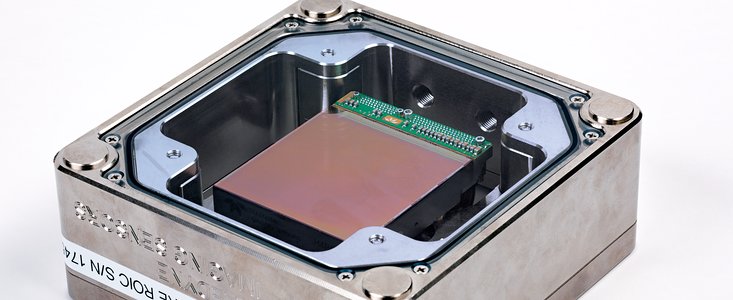Annonce
ESO Signs Agreement to Build Detectors for MOONS
The world-class MOONS spectrograph will use the largest near-infrared detectors available
20 juin 2016
ESO has signed an agreement with Teledyne Scientific & Imaging [1] to build the detectors for the new MOONS instrument that will be mounted on ESO’s flagship telescope, the Very Large Telescope (VLT) on Cerro Paranal, Chile.
The detectors are the HAWAII-4RG and they are the next generation of near-infrared detectors for astronomy. Each detector will have 16.7 million pixels, each 15 micrometers square, making them the largest near-infrared detectors currently available.
The technology draws on a long and successful heritage of similar, but smaller, detectors which have been in use at ESO’s telescopes for more than 10 years. This new next generation of detectors is expected to show the same excellent performance, and will exploit a larger active area.
The detectors represent the final stage in the construction of the very complex instrument called MOONS, the Multi-Object Optical and Near-infrared Spectrograph. MOONS, designed and built by an international consortium on behalf of ESO [2], will be equipped with four of the new detectors when it is installed on one of the four Unit Telescopes of the VLT.
MOONS will collect light (over the optical to near-infrared wavelength range) from many objects at the same time, making use of up to 1000 optical fibres to channel the light from each object to produce a separate individual spectrum. MOONS will thereby allow astronomers to gather spectra of objects over the entire field of view of the VLT (a diameter of 25 arc-minutes) in a single observation.
The infrared capabilities of MOONS will allow astronomers to study the distant Universe, and the highly obscured regions of the bulge of our Milky Way. It will observe stars within our galaxy up to a distance of about 40 000 light-years, enabling astronomers to create a three-dimensional map of our galaxy [3] and will provide the tools necessary to study galaxy formation and evolution over most of the history of the Universe.
Notes
[1] Teledyne Scientific & Imaging is a technology leader in high performance compound semiconductor devices and integrated circuits, ceramic and functional materials, efficient real-time information processing algorithms, and optical sensors and assemblies.
[2] The MOONS project brings together scientists and engineers in a consortium led by the UK Science and Technology Facilities Council’s UK Astronomy Technology Centre, Royal Observatory, Edinburgh; and including IA – Instituto de Astrofísica e Ciências do Espaço, Lisbon, Portugal; GEPI, Observatoire de Paris, France; Italian National Institute for Astrophysics (INAF) with its centres in Florence, Bologna, Milan and Rome, Italy; AIUC,Centre for Astro-Engineering, Pontificia Universidad Católica de Chile, Santiago Chile; Cavendish Laboratory and Institute of Astronomy, University of Cambridge, United Kingdom; ETH Zürich, Institute for Astronomy, Switzerland; the University of Geneva, through its Astronomical Observatory, Sauverny, Switzerland and ESO.
[3] This mapping project is particularly difficult because the Earth is in the middle of the disc of the Milky Way, so the process is a little like trying to map a forest from the inside.
Liens
- MOONS: The Multi-Object Optical and Near-infrared Spectrograph (Messenger article PDF)
- Royal Observatory Edinburgh MOONS website
- Very Large Telescope array (VLT)
- Operating the Very Large Telescope (PDF brochure)
- ESO announcement about the MOONS instrument
Contacts
Peter Hammersley
ESO, MOONS Project Manager
Garching bei München, Germany
Tel: +49 89 3200 6772
Email: phammers@eso.org
Richard Hook
ESO, Public Information Officer
Garching bei München, Germany
Tel: +49 89 3200 6655
Cell: +49 151 1537 3591
Email: rhook@eso.org
À propos de l'annonce
| Identification: | ann16036 |

